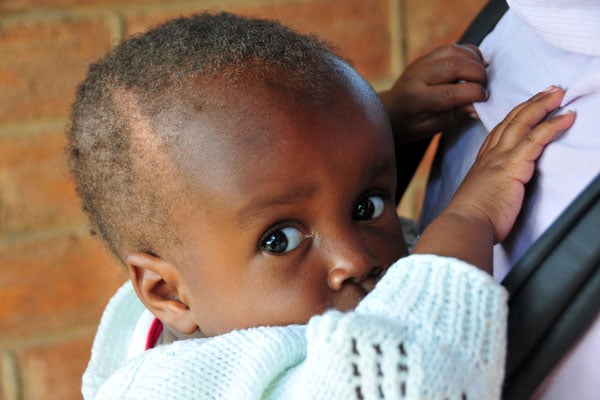Why stunting in children under five years is reducing

Researchers say reduction in stunting has been achieved through polices aimed towards maternal health and education. PHOTO/wfp.org
What you need to know:
- According to research, the most important drivers of stunting decline among children under five have been the increased use of insecticide-treated mosquito nets, improved maternal nutrition and maternal education.
Following research, scientists from Makerere School of Public Health and partners across the country have revealed that since 2016, stunting rates among children aged five years and below has reduced. This is attributed to efforts geared towards malaria prevention using treated mosquito nets.
On March 31, while explaining the research results, Dr Richard Kajjura, one of the researchers, said his team examined the national, community, household and individual level factors that have driven stunting reduction in Uganda from 2000 to 2016 using mixed methods.
“The national stunting prevalence decreased by 16 per cent while mean height between birth and five years improved by 0.55. However, improvements were not consistent across all regions, with the northern region experiencing the slowest gains. Child stunting prevalence was consistently lower among the rich, educated, and urban households. The most important drivers of stunting decline among children under five were increased use of insecticide-treated mosquito nets, improved maternal nutrition and improved maternal education,” he said.
“Effects on stunting may have also been achieved through reduced malaria prevalence among children and continued strengthening of Uganda’s health system through outreach by Village Health Teams (VHTs). Other factors include community level behaviour, change in communication strategies and increased number of health facilities and increased coverage of direct and indirect nutrition interventions,” Dr Kajura noted.
Background
Dr Kajura says his team designed the study to investigate the trends, determinants and success factors among countries that had achieved a rapid rate of childhood stunting reduction relative to their economic growth.
Phase one of the project comprised five countries that decreased stunting by almost 50 per cent over a 15-20 years period. These include Peru, Kyrgyzstan in central Asia, Nepal, Senegal and Ethiopia with a reduction rate of 70 per cent.
Results from Phase one suggested that stunting declines were driven by advances from both within and outside the health sector, including higher maternal education, improved household wealth, access to improved sanitation and the scale up of certain health and nutrition interventions.
Building on these findings, the second phase of the project aimed to explore two additional exemplar countries, which have had an outsized reduction in stunting, along with three counterfactual countries, which have not managed to reduce their national level of stunting despite economic growth and improvements in other sectors.
Uganda was chosen as a phase two exemplar country because of its considerable reduction in childhood stuntingby 18 per cent over the past 30 years. The figures indicate that stunting declined from 48 per cent in 1988 to 29 per cent in 2016.
Since the early 2000s, Uganda has experienced considerable poverty reduction, decreased maternal, newborn and child mortality, increased adult and youth literacy and female empowerment, increased livestock and cereal production, improved access to maternal care, and widespread malaria-reduction strategies, all of which link to a multifactorial stunting reduction success story.
Process
Dr Peter Waiswa, a member of the research team, says his team used data from Serere District in eastern Uganda and Kasese District in western Uganda to examine the stunting rates. The indicators are that Serere has the least stunting rates of babies under the age of five in the entire country rated at 15 per cent while Kasese has the highest rate at 45 per cent.
In the Toro region and the entire western region, the figures indicate that out of every two children born, one will be stunted. This is because the families consume mono-type foods, meaning that if a family cooks posho with cassava leaves as a vegetable, this will be consumed for both lunch and supper.
This is not the case in eastern and northern regions, where one dish contains cross cutting nutrients. For example, if a family prepares beans, vegetables and peanut butter are added. This will only be taken forlunch and different food will be cooked for supper.
Key findings
One of the key findings identified by the researchers is that mothers are now knowledgeable on which nutritious food and porridge to give their children. The team also thanked the Ministry of health for bringing VHT’s closer to communities since this way, parents easily seek medical care for their children.
Other important factors include maternal and newborn care, paternal education, access to piped water, increased household wealth, reduced open defecation, women empowerment and reduction in diarrhoea, improved inter-pregnancy interval and decline in adolescent births.
Insecticide-treated bed mosquito net coverage, along with preventive and curative approaches in pregnancy, worked to reduce maternal malaria burden and subsequently, improve health hazard effects at birth.
Financing for nutrition
The team said in the last two decades, the expenditure used to reduce stunting focused on water, sanitation and hygiene, mainly funded under the Uganda Nutrition Action Plan (Unap) programme through the Ministry of health.
The enhanced food diversity programme which was implemented from 2008-2015 cost $1.2 billion (about Shs4.3tr). It covered promotion of nutrition for babies with foods rich in Vitamin A, Iron and Zinc plus good breast feeding practices.
Policies
Dr Waiswa says while collecting this data, the team discovered that some of the existing policies are a major actor for stunting rates to drop. Some of them are the food and drug policy, child survival policy, nutrition of HIV/Aids and Tuberculosis policy and baby meal hospital initiative policy of 1996.




